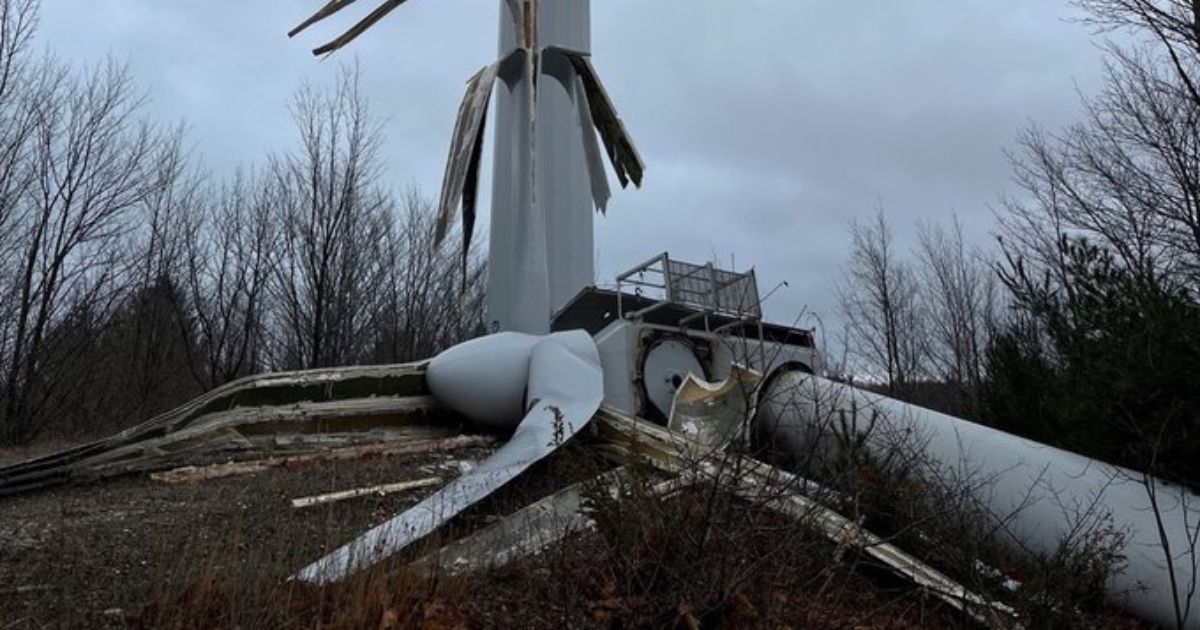Just like socialism, the idea of renewable energy generated by wind turbines supplanting fossil fuels sounds good in theory, but in practice it’s a very different story.
In the latest snafu, a wind turbine in Northport, Michigan, broke off and crashed to the ground after strong winds caused it to spin out of control, the Traverse City Record-Eagle reported Tuesday.
The turbine, which is a rotary engine, is owned by Leelanau Community Energy, which says its goal is for Leelanau County to become “100-percent powered by clean, renewable energy sources.”
Douglas McInnis, a manager for the group, said the turbine had been offline awaiting maintenance when it collapsed last week.
In other words, the turbine — which is supposed to convert wind into electricity — was already not operational when it broke because of a gust.
Theoretically, one would hope that strong winds would be welcome so it could produce even more electricity — and not cause a malfunction.
McInnis said high winds in the area last week probably caused the top part of the 163-foot tower to break off.
“That’s the assumption, that it was probably a gust of wind that broke off the top 25 feet or so,” he told the Record-Eagle.
Northport Trustee Will Harper said high wind speeds “caused the turbine to spin out of control and eventually fall to the ground,” WPBN-TV in Traverse City reported.
High wind speeds reportedly caused the turbine to spin out of control and eventually fall to the ground.https://t.co/r51tk3VSuB
— upnorthlive.com (@upnorthlive) December 21, 2022
The turbine was installed 12 years ago to supply energy to a local wastewater treatment plant.
In a farcical irony, the plant still has power — despite the turbine failure — because it’s connected to the electric grid, which is powered by fossil fuels.
If a turbine that’s supposed to generate electricity for a small water treatment plant for a community of 22,000 residents is so unreliable, how can radical environmentalists claim that “renewable energy sources” can power a nation of 332 million people?
These wind turbines have a checkered history of breaking or failing whenever the weather gets a little bad.
Several such debacles were documented between July and August alone.
RAW: A wind turbine in Texas caught fire after it was reportedly struck by lightning on Friday.
It created smoke rings in the air as the blades kept spinning. pic.twitter.com/uJx9bCRBNR
— DW News (@dwnews) July 23, 2022
Blade Tumbles Off Wind Turbine In Gloucester
Massachusetts Another Wind Turbine Fiasco
https://t.co/5G2GZDB1HC pic.twitter.com/Hle0CVviVo— Frank Haggerty (@BillCarson2162) July 31, 2022
This is near Cromwell, OK. Brent Havins shot this video of a wind turbine that got struck by lightning. pic.twitter.com/jBjUNas0yc
— Mike Collier (@MikeCollierWX) July 22, 2022
Oklahoma wind turbine bent in half, on fire, in wild video https://t.co/f6uuzfDZKl pic.twitter.com/4pFpFFXqVL
— New York Post (@nypost) August 10, 2022
Right now, there’s a massive push by the Biden administration to force a rushed transition away from fossil fuels to so-called renewable energy.
This move is being driven by jet-setting climate alarmists and radical environmentalists who screech that the world is going to end soon if we don’t stop using fossil fuels.
While the idea of transitioning to renewable energy is laudable, it cannot be forced or rushed based on hysteria.
Environmental expert Cornelis van Kooten, an economics professor at the University of Victoria in British Columbia, is one of many experts who are sounding the alarm about governments making rash policy moves based on half-baked ideas.
In a Dec. 13 commentary titled ‘Renewable’ energy can’t replace fossil fuels published by the Fraser Institute, van Kooten said climate activists wrongly assume that countries can run solely on wind and solar power at no significant cost to their citizens, economies or the environment.
He shredded an October 2021 paper published in the British scientific journal Nature that claimed a world without fossil fuels is possible.
Specifically, van Kooten said renewable energy sources are not very reliable and would end up causing numerous power disturbances that would inconvenience and endanger the public.
“The study finds that, on average, countries would experience a minimum of 788 hours per year of blackouts (defined as hours when renewable energy was insufficient to meet electricity demand),” he wrote.
“For context, that means you would be without power 9 percent of the time because renewable power would be insufficient to meet demand. Moreover, some countries in the analysis could expect to be without power 28 percent of the time.”
Imagine regular power outages at a hospital, especially in maternity wards or intensive-care units where patients are hooked up to life-support machines that depend on reliable electricity.
“The lack of real-world constraints included in the analysis is astounding,” van Kooten observed. “Simply put, the analysis is of a world that does not yet exist.”
He also noted that proponents of “renewable” energy ignore the environmental damage caused by the mass construction of the infrastructure needed to support these systems.
“Turbines require massive amounts of steel and concrete,” van Kooten wrote. “Just the steel required for wind turbines would represent 34.0 percent to 51.4 percent of the annual present capacity of the entire global steel industry.
“In other words, a renewables-only future would require building more steel capacity in the short term, and perhaps into the future —costs that are ignored in the analysis.”
Contrary to the pipedreams of climate alarmists, energy transitions take time. You cannot force such a transition on an expedited timeline without incurring grave costs to the public — and to the environment they claim to champion.
This article appeared originally on The Western Journal.
























